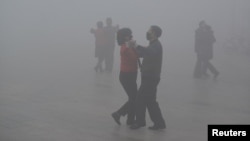The Chinese capital was on the second-highest level of smog alert Tuesday, but city officials said the air quality was improving overall, citing data for last year.
Hundreds of flights were canceled and highways were closed across northern China over the new year holiday as average concentrations of small breathable particles known as PM2.5 soared above 500 micrograms per cubic meter in Beijing and surrounding regions.
Pollution alerts are common in northern China, especially during bitterly cold winters when energy demand, much of it met by coal, soars.
But the Beijing Municipal Environmental Protection Bureau told state media that PM2.5 concentrations dropped 9.9 percent on the year to an average of 73 micrograms per cubic meter in the capital in 2016.
The total number of "blue sky days" reached 198 last year, up 12 from 2015. However, the average PM2.5 measure still exceeded national air quality standards by 109 percent, the bureau said.
Beijing also cut total coal consumption to below 10 million tonnes in 2016, down from 23 million in 2013. It closed 335 polluting factories and ordered 424,000 obsolete high-emitting vehicles off the road last year, state news agency Xinhua said.
Red alert
Despite a brief respite Monday, smog returned to the Chinese capital on Tuesday, with PM2.5 readings again at "hazardous" levels. Smog is expected to persist in the region until a cold front arrives January 8, Xinhua said.
China's weather bureau also issued its first ever fog red alert on Tuesday, saying that visibility could fall below 50 meters across northern China.
Poor visibility prompted three major northern ports to suspend the loading of ships Tuesday, maritime safety agencies said.
China is in the third year of a "war on pollution" aimed at reversing the damage done to its skies, soil and water after decades of untrammeled economic growth.
It has created emergency response systems to curb traffic and shut down factories and construction sites during periods of heavy smog, and has also vowed to punish local officials and enterprises that break rules.
During a bout of smog in December, inspectors identified 21 enterprises that had violated regulations.
Over the new year, 10 more inspection teams went to cities across the region and more than 500 enterprises and construction sites, as well as 10,000 drivers, were punished for breaches, Xinhua said.
On Tuesday, the smoggiest province, Hebei, said six local enterprises had violated emergency restrictions during the latest alerts, with one refusing entry to inspectors.







